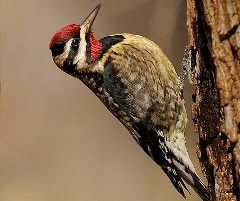Over the last week I've been watching robins hop around my yard, picking out old plant stalks and other bits and pieces to build their nests. There's a pair working on a nest in the rose trellis over our front sidewalk -- always an exciting location, because we can watch the parents feed their babies from our porch. Plus, every time someone passes through our front gate a bird comes flying out!
Most nests are a little harder to see. They're usually in out-of-the-way places, and sometimes fiercely protected -- as I once learned when some mockingbirds built a nest in my hedge (I was seriously concerned for a minute there that my eyes would get pecked out). And actually, it's bad when humans get too close to bird nests anyway -- some species will abandon a nest if they are too bothered by the intrusion.
Peter Goodfellow gives us a better look in his book Avian Architecture, which won the 2011 American Publishers Awards for Professional and Scholarly Excellence (The PROSE Awards) in Popular Science & Popular Mathematics.
Just take a moment to marvel at the diversity of bird nests. They range in complexity from the barely-there scrapes in the ground of the arctic tern to the elaborately woven nest of the oropendula; they range in size from the super-tiny cup nest of the ruby-throated hummingbird to the six-foot-deep and six-foot-wide nest of the African white stork.
In addition to grasses and twigs, birds use rocks, mud, cacti, lichen, dandelion seeds, caterpillar silk, animal hairs, and spiderwebs to build their nests. Most surprising, perhaps, is the edible-nest swiftlet, which makes its nest entirely out of spit.
Goodfellow categorizes this diversity into 12 basic architectural styles: platforms, cups, domes, holes and tunnels, scrapes, mounds, bowers, colonies, aquatic nests, mud nests, hanging and woven nests, and edible nests.
Each section of the book includes "blueprint" line drawings for archetypal examples of the style, followed by short case studies on the materials and techniques birds use (examples here). The building technique pages are my favorites: the step-by-step drawings of how birds actually put a nest together really bring to life how much effort goes into the process.
My one complaint is that in seeking the diversity of nests from around the world, the book includes a relative scarcity of birds from our region. Of over 80 species illustrated in the book, only 13 are native to the mid-Atlantic.
My neighbors the robins make an appearance, but I have to say their nest architecture pales in comparison to some of the other locals Goodfellow picks:
- The bald eagle builds an 8-foot wide platform nest that can weigh two tons and last for over 50 years.
- The nest of a ruby-throated hummingbird is held together with spiderwebs, and is "smaller than a shot glass."
- Red-winged blackbirds weave their cup nests around the stems of plants that are growing in the water, giving eggs protection from land-based predators.
- Cliff swallows build colonies of tube-shaped nests out of mud attached to a rock wall.
- The Baltimore oriole makes about 10,000 stitches to weave a nest that hangs down from the branches of a tree.
The giveaway:
Princeton University Press sent me a free review copy of this book, and I'd like to pass it on to one of you. There are two ways to enter:
1. Go to our Facebook page and "share" one of our recent posts.
2. Go to our Twitter feed and retweet one of our tweets.
Deadline is midnight on Friday, April 6. If you're selected I'll contact you to ask for your address.
Don't win the giveaway? Your local library probably has a copy. If you buy the book through this link
















